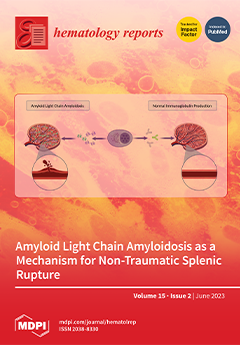Open AccessConference Report
Managing Relevant Clinical Conditions of Hemophilia A/B Patients
by
Massimo Morfini, Jacopo Agnelli Giacchiello, Erminia Baldacci, Christian Carulli, Giancarlo Castaman, Anna Chiara Giuffrida, Giuseppe Malcangi, Angiola Rocino, Sergio Siragusa and Ezio Zanon
Cited by 2 | Viewed by 3791
Abstract
The Medical Directors of nine Italian Hemophilia Centers reviewed and discussed the key issues concerning the replacement therapy of hemophilia patients during a one-day consensus conference held in Rome one year ago. Particular attention was paid to the replacement therapy needed for surgery
[...] Read more.
The Medical Directors of nine Italian Hemophilia Centers reviewed and discussed the key issues concerning the replacement therapy of hemophilia patients during a one-day consensus conference held in Rome one year ago. Particular attention was paid to the replacement therapy needed for surgery using continuous infusion (CI) versus bolus injection (BI) of standard and extended half-life Factor VIII (FVIII) concentrates in severe hemophilia A patients. Among the side effects, the risk of development of neutralizing antibodies (inhibitors) and thromboembolic complications was addressed. The specific needs of mild hemophilia A patients were described, as well as the usage of bypassing agents to treat patients with high-responding inhibitors. Young hemophilia A patients may take significant advantages from primary prophylaxis three times or twice weekly, even with standard half-life (SHL) rFVIII concentrates. Patients affected by severe hemophilia B probably have a less severe clinical phenotype than severe hemophilia A patients, and in about 30% of cases may undergo weekly prophylaxis with an rFIX SHL concentrate. The prevalence of missense mutations in 55% of severe hemophilia B patients allows the synthesis of a partially changed FIX molecule that can play some hemostatic role at the level of endothelial cells or the subendothelial matrix. The flow back of infused rFIX from the extravascular to the plasma compartment allows a very long half-life of about 30 h in some hemophilia B patients. Once weekly, prophylaxis can assure a superior quality of life in a large severe or moderate hemophilia B population. According to the Italian registry of surgery, hemophilia B patients undergo joint replacement by arthroplasty less frequently than hemophilia A patients. Finally, the relationships between FVIII/IX genotypes and the pharmacokinetics of clotting factor concentrates have been investigated.
Full article






